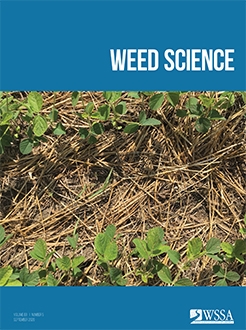Knowledge of crop–weed interference effects on weed biology along with yield penalties can be used for the development of integrated weed management (IWM) tactics. Nevertheless, little is known about the beneficial effects of soybean [Glycine max (L.) Merr.] density, an important aspect of IWM, on late Palmer amaranth (Amaranthus palmeri S. Watson) establishment time. Two field experiments were conducted in 2014 and 2015 to investigate how various soybean densities and A. palmeri establishment timings in weeks after crop emergence (WAE) affect height, biomass, and seed production of the weed but also crop yield in drill-seeded soybean. Soybean density had a significant impact on dry weight and seed production of A. palmeri that established within the first 2 wk of crop emergence, but not for establishment timings of the weed 4 wk and later in relation to crop emergence. Differential performance of A. palmeri gender was observed, regarding greater biomass production of female than male plants under crop presence, and merits further investigation. Grain yield reductions were recorded at earlier A. palmeri establishment timings (i.e., 0 and 1 WAE) compared with 8 WAE establishment timing in 2014 and 2015. High soybean densities resulted in greater soybean yields compared with low soybean density, but no grain yield benefits were observed between medium and high soybean densities. Crop budget analysis revealed the benefits of moderate seeding rate (i.e., 250, 000 seeds ha–1) increases in comparison to lower (i.e., 125,000 seeds ha–1) or high (i.e., 400,000 seeds ha–1) on crop revenue, net income returns, and breakeven price. Earlier A. palmeri establishment timings (i.e., 0, 1, and 2 WAE) resulted in lower crop revenue and net income returns compared with later establishment timings of the weed.
How to translate text using browser tools
2 June 2020
Soybean Density and Palmer Amaranth (Amaranthus palmeri) Establishment Time: Effects on Weed Biology, Crop Yield, and Economic Returns
Nicholas E. Korres,
Jason K. Norsworthy,
Andy Mauromoustakos,
Martin M. Williams II

Weed Science
Vol. 68 • No. 5
September 2020
Vol. 68 • No. 5
September 2020
Crop budget
fecundity
gender
ground cover
integrated weed management
light interception
sex





